
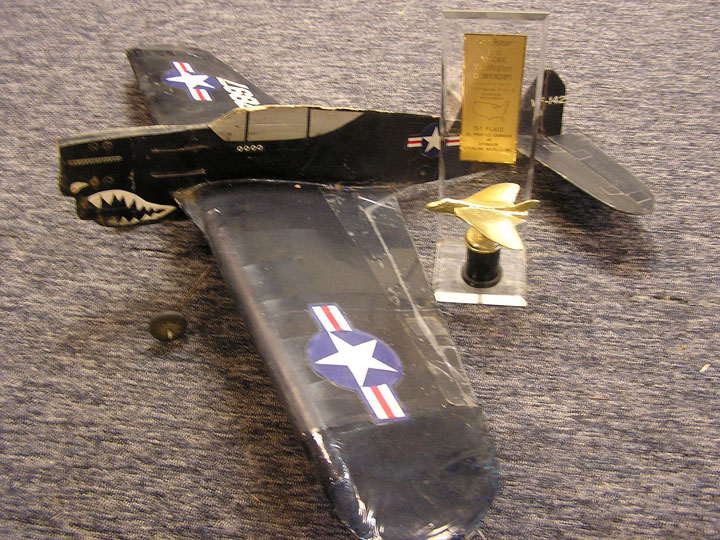
The pioneering Navy Carrier plane with its Nats trophy. Jeff Rein photo
By Jeffrey Rein
In 1973, when I was 19 years old and flying in the Senior class, I invented something I called a line slider, which was the original prototype for the modern line slider used throughout carrier today. Here is the story:
It all started when Mark Satterlee decided to go to the Nats in 1973. Mark did not want to make the trip alone so he invited me to come along for company and to help with the driving, and Scott Newkirk along for entertainment.
I was very excited about the opportunity and decided to build a new profile carrier for the Nats. I had heard of a motor man named Tom Upton who hopped up the G21 Super Tigre .35 for combat, and contacted him about hopping up my plain sleeve Super Tigre for carrier. He said he would take on the challenge, so I promptly sent him my motor. Now what new plane should I build?
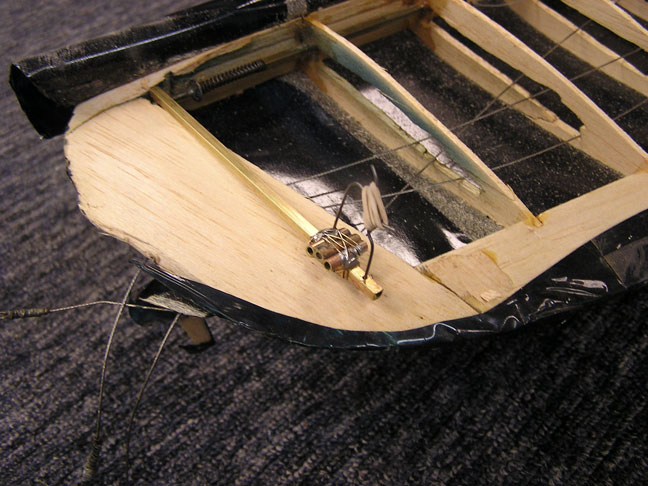 I had always liked the Curtis P-40 Warhawk and decided to build it. Only problem is they did not make a P-40 kit suitable for profile carrier. To make my dream come true I ended up purchasing a Yak-9 kit. I straightened out the leading edge, which gave the trailing edge more sweep, and there you have it, a P-40 wing. I added some 1/2” balsa to the bottom of the motor mount for the scoop, which of course I painted the teeth on, cut and shaped some, and now the plane is a P-40.
I had always liked the Curtis P-40 Warhawk and decided to build it. Only problem is they did not make a P-40 kit suitable for profile carrier. To make my dream come true I ended up purchasing a Yak-9 kit. I straightened out the leading edge, which gave the trailing edge more sweep, and there you have it, a P-40 wing. I added some 1/2” balsa to the bottom of the motor mount for the scoop, which of course I painted the teeth on, cut and shaped some, and now the plane is a P-40.
I had been experimenting with different ideas to make the plane fly very slow for the low speed flight while keeping good line tension for control. My first two attempts were disasters. My first idea was to have a swinging weight that went from the nose to the tail when I dropped the hook. My thinking was the plane would fly at a 45 degree angle and do a Saber dance. I tried it out at the NW Regional's in Eugene for the first time, (no need to actually test, right?). Well on my first official flight it was uncontrollable, and I received a lot of ribbing and laughter from the contestants. Glad I can laugh at myself or I might get a complex. I disabled the weight and won the contest anyway.
Later, I got this great idea to drag a parachute behind the plane. I put it on a bridle between the back of the plane and the outboard wing tip. Infinitely adjustable, it has to work. This time, I tested it in private. Good thing, too, because it was another disaster that I could not control in flight. Hmmm, zero for two so far, maybe I should quit.
Then I started to think about what Chuck Thomas told me about rat race. He said put the lead out position forward towards the leading edge, which will make the plane point inwards which would result in less line tension and more speed. In carrier, your plane needs to fly fast and slow. I thought if the lines were as far forward for the fast flight I would get more speed. However, what I needed for slow speed is for the plane to point out for good line tension. What if I could figure out a way to start out with them forward, then when I fly my slow speed, find a way to sweep my leadouts back to the trailing edge. Cool! I became obsessed with the idea. This was going to be installed in my P-40 to take to the Nats. Now all I had to do was invent it!
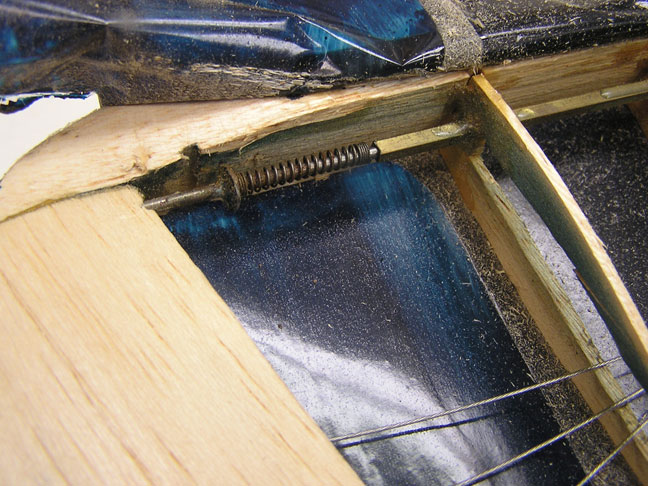 I went to the hobby shop to look around for some inspiration to build this thing that I had not invented yet. I started playing around with this square brass tubing when bam, a light went off in my head and I said “I got it.” I bought a piece of 1/8” brass square tubing and a piece of square tubing the next size larger that slid perfectly over the smaller one, and some 1/8” round tubing. I had already framed my wing so when I got home it was ready to install this invention that was in my head. First I cut a piece of 1/8” square tubing a little longer than the wing tip. Next I cut 1”piece of the larger square tubing and slid it on to the 1 /8” tubing. It would slide forward to aft with ease and maintain it's horizontal orientation. Then I cut three pieces of 1/8” round tubing 3/4” long, wrapped them in position with copper wire and soldered. These would become my three leadout guides that would slide forward and aft atop the larger square tubing. All I had to do now was find a way to hold it the in the forward position during the high speed run, trigger them on command to move to the aft position, and keep them there for the rest of the flight.
I went to the hobby shop to look around for some inspiration to build this thing that I had not invented yet. I started playing around with this square brass tubing when bam, a light went off in my head and I said “I got it.” I bought a piece of 1/8” brass square tubing and a piece of square tubing the next size larger that slid perfectly over the smaller one, and some 1/8” round tubing. I had already framed my wing so when I got home it was ready to install this invention that was in my head. First I cut a piece of 1/8” square tubing a little longer than the wing tip. Next I cut 1”piece of the larger square tubing and slid it on to the 1 /8” tubing. It would slide forward to aft with ease and maintain it's horizontal orientation. Then I cut three pieces of 1/8” round tubing 3/4” long, wrapped them in position with copper wire and soldered. These would become my three leadout guides that would slide forward and aft atop the larger square tubing. All I had to do now was find a way to hold it the in the forward position during the high speed run, trigger them on command to move to the aft position, and keep them there for the rest of the flight.
What I did was solder a vertical piece of 1/16” piano wire to the front of the sliding mechanism that stuck out of the top of the wing, and bent a hook facing forward to accept a rubber band. Then I soldered another piece at the trailing edge facing the other way. The rubber band would be installed in the two hooks. The trigger was the fun part. I installed a piece of tubing on the back of the leading edge near the wing tip. Then took a 6” piece of piano wire, soldered a washer 1” from the end. I put a BIC pen spring behind the washer and slid it into the horizontal tubing glued to the back of the leading edge. When the spring was not compressed, the piano wire would latch behind the front hooked piano wire on the line slider holding it in the forward position. Lastly, I connected the other end of the latch with a piece of old combat lines to the up side of the bell crank. When latched, the lines would stay forward held by the pin. When I pulled full down to drop my hook for slow speed, the bell crank would pull the line tight, compress the spring which it turn released the line slider, then the rubber band would pull the lead outs to the aft position.
By this time I had received my hopped up motor and all I had to do was finish the plane, run the motor, and test the plane. The only problem was I had to leave for the Nats in three days. (It seems that I had lost my focus on the timetable when I discovered girls and parties). 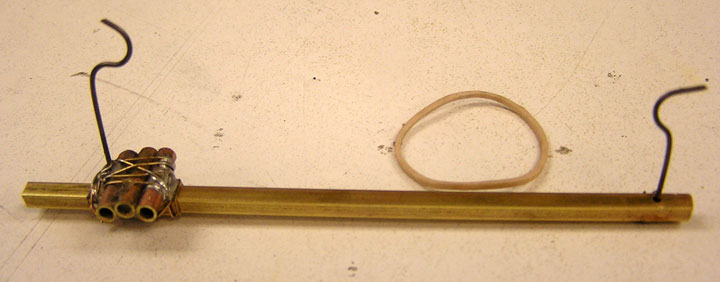 When I told Norm McWright of my situation, he invited me over to his place to help me finish it, which is what I did. About four hours into our building session it was getting late in the afternoon. Norm looks at my progress and say's “Jeff, I think we need to pull an all nighter to get this thing done”. I agreed and we worked until 7 the next morning. Finally it was completed, teeth and all, ready to fly. I was pretty beat and wanted to go home to take a long nap, but no, Norm is full of energy and suggests we go watch the world championships for boat racing that was going being held at Green Lake that weekend. I had never seen model boat races before so it turned out to be a real treat. Not only was it exciting to watch a world championship event, but I was able to watch Ed Fisher's daughter destroy the Japanese, French and Spanish teams. The boats were flying around the course at what I thought was incredible speed until someone caught up with Fisher's boat, then bam, she would hit full throttle and walk away like they were standing still. I had later learned that Fisher was an ex-controline racer and speed guy who was a master with motors.
When I told Norm McWright of my situation, he invited me over to his place to help me finish it, which is what I did. About four hours into our building session it was getting late in the afternoon. Norm looks at my progress and say's “Jeff, I think we need to pull an all nighter to get this thing done”. I agreed and we worked until 7 the next morning. Finally it was completed, teeth and all, ready to fly. I was pretty beat and wanted to go home to take a long nap, but no, Norm is full of energy and suggests we go watch the world championships for boat racing that was going being held at Green Lake that weekend. I had never seen model boat races before so it turned out to be a real treat. Not only was it exciting to watch a world championship event, but I was able to watch Ed Fisher's daughter destroy the Japanese, French and Spanish teams. The boats were flying around the course at what I thought was incredible speed until someone caught up with Fisher's boat, then bam, she would hit full throttle and walk away like they were standing still. I had later learned that Fisher was an ex-controline racer and speed guy who was a master with motors.
Traveling with Mark Satterlee turned out to be an experience. He grew up in Montana and knew the rules of the road, (no rules). “No daytime speed limit,” he said. First he got in a race with an Oldsmobile to 115 mph. Later he passed a highway patrol doing 85, only to be pulled over for a defective tail light. Then he said “You know, there is no drinking age in Montana. I called B.S. That night when we went to a restaurant for dinner, he promptly told the waiter to “bring the boys a beer!” Now I was 19, and Scott Newkirk was 15. Two minutes later our beers arrived and I drank my beer and ate my words. After two and a half long days driving, we finally arrived in Oshkosh, Wis.
After we settled into the college dorms, we were eager to see the field and test fly, first we had to process and weigh our planes. My plane weighed in at 31 ounces, and the official said it was the heaviest one he had weighed all day. Well the line slider added a bit of weight to the inboard tip, so a chunk of lead on the outboard tip was necessary to balance it correctly. I was beginning to think I had made a big mistake by installing that heavy thing on my plane.
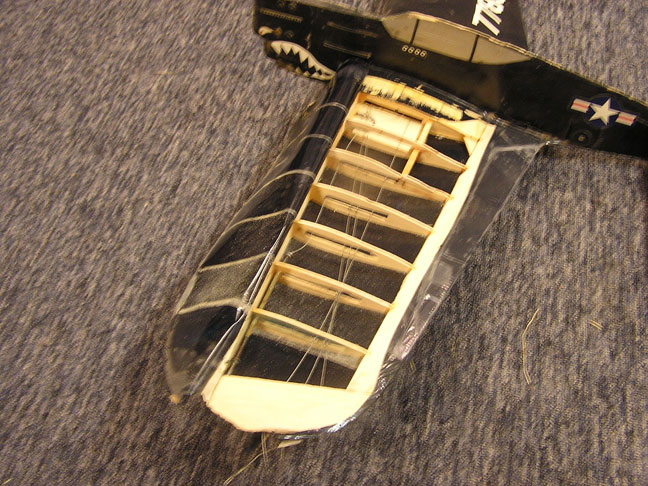 After processing I wanted to put a test flight on my new plane, new line slider, and new stage three hopped up Super Tigre. We rolled out the lines, checked the controls and fired up the engine. Good so far. We hand launched at high throttle. The plane flew perfectly with good throttle response. Now I can drop the hook, activate my line slider and see how well the plane performs at the slowest speed. I jerked full down, my hook dropped, my control locked up, and my brand new plane on its maiden flight smashed into the ground. I was shocked. What the heck happened? I went up to the plane, picked up all of the pieces and wondered “what am I going to do now? Carrier is tomorrow.”
After processing I wanted to put a test flight on my new plane, new line slider, and new stage three hopped up Super Tigre. We rolled out the lines, checked the controls and fired up the engine. Good so far. We hand launched at high throttle. The plane flew perfectly with good throttle response. Now I can drop the hook, activate my line slider and see how well the plane performs at the slowest speed. I jerked full down, my hook dropped, my control locked up, and my brand new plane on its maiden flight smashed into the ground. I was shocked. What the heck happened? I went up to the plane, picked up all of the pieces and wondered “what am I going to do now? Carrier is tomorrow.”
Upon further evaluation I discovered a design flaw. I had put all threelead outs right next to each other on the slider which caused the connectors to jam up when I had pulled full down. After some brainstorming we decided that some surgical tubing over the line connectors would solve the jamming problem, but what about the plane? While I was deflated, Mark was confident that I could fix it. Off to town to find the local hobby shop. I purchased some balsa, glue, covering, butyrate dope, and some surgical tubing. Just as we left the hobby shop, the sky opened up and started dumping rain. Everyone in town was standing on the sidewalk under protective eaves, reading a book or talking and waiting for the rain to stop. I thought how odd; I come from Seattle where it rains 300 days per year. If we waited for the rain to stop, we would never get out of the house, so Mark, Scott and I make a mad dash for the car. By the time we made it half way across the street we were drenched. The rain sure is a lot wetter in Oshkosh than it is in Seattle, I thought. Then we noticed there was a river running down the street like I had never seen before. I imagine the locals found us quite amusing.
When we got back to our dorms I promptly started to repair the damage I had created two hours earlier. After about seven hours, I was beat and needed a break so I decided to socialize with my buds. The next thing I knew was in Tom Upton's room and he was explaining how he hops up his Stage 3 G21 Super Tigre engines. I learned a wealth of knowledge in about 30 minutes. What an education. Then he pulls this motor out and says he built this highly modified Stage 5 motor which he said he clocked at 135 MPH! Epoxy stuffed everywhere and just cool looking. Back in 1973, 135 MPH was about 15 MPH faster than the fastest motors. He said he was looking for a promising young junior or senior combat flyer to loan it to for use at the Nationals. I shyly raise my hand and say “I am a senior and am flying combat.” To my total surprise he said sure kid, use it. I was overwhelmed. I used it two days later, (another story).
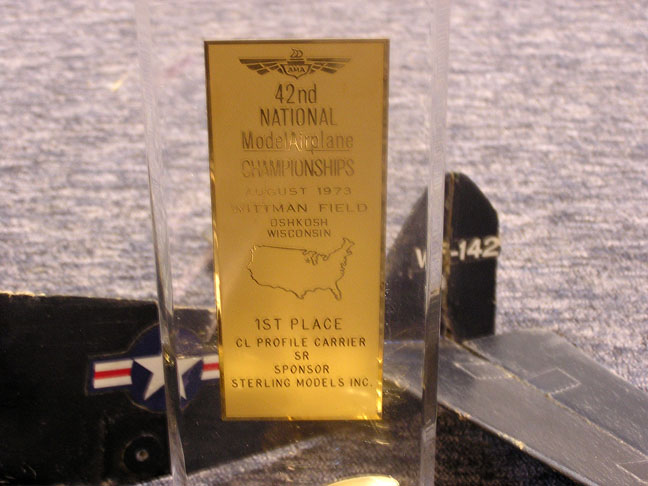 We picked up a quart of PBR and went back to my dorm to work on the plane. It was too hot and muggy to sleep so I spent the rest of the evening trying to repair my plane. I finished sometime after 3 a.m. and promptly crashed (me, not my plane) from exhaustion.
We picked up a quart of PBR and went back to my dorm to work on the plane. It was too hot and muggy to sleep so I spent the rest of the evening trying to repair my plane. I finished sometime after 3 a.m. and promptly crashed (me, not my plane) from exhaustion.
Carrier started first thing in the morning, so there was no time for a test flight. I put the plane on the deck, fueled it up, started it, and took off. The high speed run went well, several mph faster since the hop up job. Then I dropped the hook and activated the line slider while throttling down. It worked perfectly. The plane would hang out nicely, even in the wind. My last concern was that the motor might die at idle do to the porting changes that Tom had made. Luckily this was a non-issue and I finished my low speed flight with confidence that I had flown my best score ever.
When it comes to landing, I have never received less than 100 points. I like to float it down, make a three point landing, motor still idling after landing and walk up to pinch the fuel after the flight was over. I had even made an improved hook for my P-40. It was aerodynamic, tucked neatly into the fuselage almost out of sight, and I installed a feather wire on it so when I snagged the arresting line it would trap the line in the hook. I approach for the landing, everything is perfect, I drop to two inches above the deck, then I watch my hook bounce off of the deck twice. I gave it throttle before I fell off of the deck to come around for a second attempt. The same thing happened. After 10 more tries, I gave up. No matter what I did, the hook would not grab the line. It just bounced off of the deck like a rubber ball. When I landed I went over to the plane to try and figure out what had gone wrong. I soon realized that nothing had gone wrong, only my engineering. So much for my aerodynamic hook.
I promptly rebent the hook to resemble the hook that I used on my previous carrier planes, held it just over the deck to see if it would work correctly, then got ready for my final attempt. The high speed run went well as expected. By now the wind had kicked up, making the slow speed run more difficult, as we do not have these strong winds in the Seattle area. Still worried about the motor dieing at idle, I would gun the motor now and then while hanging in the wind. I could not afford a flame out on my last attempt. At the completion of my slow speed run I felt I did good enough and signaled for landing. As I floated over the deck, a gust of wind picked my plane up about a foot and could not recover. Miss number one. That's it, this is getting old real quick I am going to make the landing on the next pass, or crash trying. When I got over the front of the deck I gave it some down which resulted in a much harder than usual but arrested three point landing that earned me 95 points.
After I brought my plane back to the pits I went over to check out my score. It turned out that still with a 95 point landing I had moved into first place with a 0.73 point lead. That lead held for the rest of the day and that is how I won the senior national profile carrier championship using the brand new line slider that I had invented. To quote Paul Harvey “And now you know, the rest of the story.”
I still have that National winning P-40 after all these years. Although I removed the hook and part of the line slider in the 80's to sport fly the model, the triggering mechanism is still intact. I removed the top covering off of the inboard wing and took some pictures to verify my story. I also built a replica of the sliding mechanism to give the reader a better understanding of what it looked like.
My first and last match in fast combat was flown against some kid from Texas named Stubblefield. You can borrow the fastest motor on the planet but it is no match against superior talent. To quote Rich Tupper “I was cut up like a Safeway chicken."
Goodyear racing turned out to be very entertaining. It was a very windy day and that made it tough to fly. I had already completed my race and was watching the final race to see where I would place. It looked like I would probably finish in fifth place when all of a sudden I saw a pilot take off with a wingover in the high wind. It seems that when he pulled the wingover, he got under someone else's lines. Now there are two planes doing loops. Mark and I are watching the race with excitement once we realized the possible implications. The next thing we saw was one of the planes splat straight in to the pavement. We jumped up and yelled hurray, we just got fourth place. Moments later the other plane met the same fate and exploded when it hit the concrete. We jumped up with joy and yelled again “third place.”
Now all the people around us must have thought we were some sort of deranged sadists or something, but in fact we were celebrating our third place national trophy that we had earned by not crashing our plane like the competition. Maybe we were a little deranged after all.
The only other notable event that occurred on the trip was Mark took a nap in North Dakota for three hours. When we got gas in Montana he woke up and calculated I had averaged a speed of 100 MPH for the last three hours. He decided to drive the rest of the way home.
Other innovations include, but are not limited to:
1972 - First to build and use foam construction for combat planes in the Northwest.
1973- One of the original three contestants to fly in a fast combat competition held inside a recreational yard at a state penitentiary.
1974 - Wrote and recorded the best selling song about control-line entitled “Fokken A”
1974 - Flew 360-degree wingovers with a fast combat plane 100' above the ground on a train trestle in Bellevue, which was located three blocks from the police station.
1995 - Designed, competed, and won the Nats with a variation of the “Sword of Death,” which is a 1/2A combat plane with a 48” wingspan.
1995 - Designed, manufactured, and marketed unbreakable connecting rods for the powerful VA .049.
1998 - Introduced the use of plastic streamers for combat contests.
2003 - Designed and co-manufactured the popular H&R Combat Shutoff.
2010 - Introduced seven round match fast combat at the Bladder Grabber.
This page was upated Sept. 2, 2010